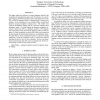70 search results - page 2 / 14 » Towards Lower Error Rates in Phoneme Recognition |
ICASSP
2008
IEEE
13 years 11 months ago
2008
IEEE
Phoneme set clustering of accurate modeling is important in the task of multilingual speech recognition, especially when each of the available language training corpora is mismatc...
ICASSP
2010
IEEE
13 years 5 months ago
2010
IEEE
In this paper, we present a robust spectro-temporal feature extraction technique using autoregressive models (AR) of sub-band Hilbert envelopes. AR models of Hilbert envelopes are...
ICASSP
2010
IEEE
13 years 5 months ago
2010
IEEE
This paper studies the influence of n-gram language models in the recognition of sung phonemes and words. We train uni-, bi-, and trigram language models for phonemes and bi- and...
EJASMP
2010
13 years 3 days ago
2010
With ageing, human voices undergo several changes which are typically characterized by increased hoarseness and changes in articulation patterns. In this study, we have examined t...
CORR
2007
Springer
13 years 5 months ago
2007
Springer
— It has been observed that particular rate-1/2 partially systematic parallel concatenated convolutional codes (PCCCs) can achieve a lower error floor than that of their rate-1/...

